Self-Humidifying Proton Exchange Membranes for Fuel Cell Applications: Advances and Challenges
Abstract
:1. Introduction
2. Self-Humidifying PEMs Incorporated with Inorganic Additives
3. Self-Humidifying PEMs Incorporated with Highly Proton-Conductive Additives
4. Self-Humidifying PEMs Incorporated with Carbon-Based Additives
5. Prevailing Challenges and Possible Remedies
6. Future Prospects of Self-Humidifying PEMs
7. Conclusions
Author Contributions
Funding
Conflicts of Interest
References
- York, R.; Bell, S.E. Energy transitions or additions?: Why a transition from fossil fuels requires more than the growth of renewable energy. Energy Res. Soc. Sci. 2019, 51, 40–43. [Google Scholar] [CrossRef]
- Liddle, B.; Sadorsky, P. How much does increasing non-fossil fuels in electricity generation reduce carbon dioxide emissions? Appl. Energy 2017, 197, 212–221. [Google Scholar] [CrossRef]
- Shindell, D.; Smith, C.J. Climate and air-quality benefits of a realistic phase-out of fossil fuels. Nature 2019, 573, 408–411. [Google Scholar] [CrossRef] [PubMed]
- Andújar, J.M.; Segura, F. Fuel cells: History and updating. A walk along two centuries. Renew. Sustain. Energy Rev. 2009, 13, 2309–2322. [Google Scholar] [CrossRef]
- Wieser, C. Novel polymer electrolyte membranes for automotive applications–requirements and benefits. Fuel Cells 2004, 4, 245–250. [Google Scholar] [CrossRef]
- Ramadhani, F.; Hussain, M.A.; Mokhlis, H. A Comprehensive review and technical guideline for optimal design and operations of fuel cell-based cogeneration systems. Processes 2019, 7, 950. [Google Scholar] [CrossRef] [Green Version]
- Peighambardoust, S.J.; Rowshanzamir, S.; Amjadi, M. Review of the proton exchange membranes for fuel cell applications. Int. J. Hydrogen Energy 2010, 35, 9349–9384. [Google Scholar] [CrossRef]
- Luo, X.; Wang, J.; Dooner, M.; Clarke, J. Overview of current development in electrical energy storage technologies and the application potential in power system operation. Appl. Energy 2015, 137, 511–536. [Google Scholar] [CrossRef] [Green Version]
- Hermann, A.; Chaudhuri, T.; Spagnol, P. Bipolar plates for PEM fuel cells: A review. Int. J. Hydrogen Energy 2005, 30, 1297–1302. [Google Scholar] [CrossRef]
- O’hayre, R.; Cha, S.-W.; Colella, W.; Prinz, F.B. Fuel Cell Fundamentals; John Wiley & Sons: Hoboken, NJ, USA, 2016. [Google Scholar]
- Ogungbemi, E.; Ijaodola, O.; Khatib, F.; Wilberforce, T.; El Hassan, Z.; Thompson, J.; Ramadan, M.; Olabi, A. Fuel cell membranes—Pros and cons. Energy 2019, 172, 155–172. [Google Scholar] [CrossRef] [Green Version]
- Henkensmeier, D.; Sui, P.; Wong, K.; Kjeang, E.; Knights, S.; Djilali, N. Copolymer synergistic coupling for chemical stability and improved gas barrier properties of a polymer electrolyte membrane for fuel cell applications. Int. J. Hydrogen Energy 2020, 45, 7059–7068. [Google Scholar]
- Mench, M.M.; Kumbur, E.C.; Veziroglu, T.N. Polymer Electrolyte Fuel Cell Degradation; Academic Press: Pittsburgh, PA, USA, 2011. [Google Scholar]
- Singh, R.; Sui, P.; Wong, K.; Kjeang, E.; Knights, S.; Djilali, N. Modeling the effect of chemical membrane degradation on PEMFC performance. J. Electrochem. Soc. 2018, 165, F3328–F3336. [Google Scholar] [CrossRef] [Green Version]
- Luo, X.; Ghassemzadeh, L.; Holdcroft, S. Effect of free radical-induced degradation on water permeation through PFSA ionomer membranes. Int. J. Hydrogen Energy 2015, 40, 16714–16723. [Google Scholar] [CrossRef]
- Karimi, A.; Mirfarsi, S.H.; Rowshanzamir, S.; Beyraghi, F.; Lester, D. Vicious cycle during chemical degradation of sulfonated aromatic proton exchange membranes in the fuel cell application. Int. J. Energy Res. 2020, 44, 8877–8891. [Google Scholar] [CrossRef]
- Mirfarsi, S.H.; Karimi, A.; Rowshanzamir, S.; Parnian, M.J. Study of mechanical degradation of sulfonated poly (ether ether ketone) membrane using ex-situ hygrothermal cycles for polymer electrolyte fuel cell application. J. Power Sources 2018, 401, 73–84. [Google Scholar] [CrossRef]
- Khorasany, R.M.H.; Kjeang, E.; Wang, G.G.; Rajapakse, R.K.N.D. Simulation of ionomer membrane fatigue under mechanical and hygrothermal loading conditions. J. Power Sources 2015, 279, 55–63. [Google Scholar] [CrossRef]
- Dafalla, A.M.; Jiang, F. Stresses and their impacts on proton exchange membrane fuel cells: A review. Int. J. Hydrogen Energy 2018, 43, 2327–2348. [Google Scholar] [CrossRef]
- Moghaddam, J.A.; Parnian, M.J.; Rowshanzamir, S. Preparation, characterization, and electrochemical properties investigation of recycled proton exchange membrane for fuel cell applications. Energy 2018, 161, 699–709. [Google Scholar] [CrossRef]
- Parnian, M.J.; Rowshanzamir, S.; Moghaddam, J.A. Investigation of physicochemical and electrochemical properties of recast Nafion nanocomposite membranes using different loading of zirconia nanoparticles for proton exchange membrane fuel cell applications. Mater. Sci. Energy Technol. 2018, 1, 146–154. [Google Scholar] [CrossRef]
- Najmi, A.A.; Rowshanzamir, S.; Parnian, M.J. Study of physicochemical characterization of potassium-doped Nafion117 membrane and performance evaluation of air-breathing fuel cell in different alkali-methanol solutions. Energy 2016, 113, 1090–1098. [Google Scholar] [CrossRef]
- Najmi, A.A.; Rowshanzamir, S.; Parnian, M.J. Investigation of NaOH concentration effect in injected fuel on the performance of passive direct methanol alkaline fuel cell with modified cation exchange membrane. Energy 2016, 94, 589–599. [Google Scholar] [CrossRef]
- Whiston, M.M.; Azevedo, I.L.; Litster, S.; Whitefoot, K.S.; Samaras, C.; Whitacre, J.F. Expert assessments of the cost and expected future performance of proton exchange membrane fuel cells for vehicles. Proc. Natl. Acad. Sci. USA 2019, 116, 4899–4904. [Google Scholar] [CrossRef] [PubMed] [Green Version]
- US Department of Energy. DOE Technical Targets for Polymer Electrolyte Membrane Fuel Cell Components. Available online: https://www.energy.gov/eere/fuelcells/doe-technical-targets-polymer-electrolyte-membrane-fuel-cell-components (accessed on 3 August 2020).
- Parnian, M.J.; Rowshanzamir, S.; Gashoul, F. Comprehensive investigation of physicochemical and electrochemical properties of sulfonated poly (ether ether ketone) membranes with different degrees of sulfonation for proton exchange membrane fuel cell applications. Energy 2017, 125, 614–628. [Google Scholar] [CrossRef]
- Parnian, M.J.; Gashoul, F.; Rowshanzamir, S. Studies on the SPEEK membrane with low degree of sulfonation as a stable proton exchange membrane for fuel cell applications. Iran. J. Hydrog. Fuel Cell 2017, 3, 221–232. [Google Scholar]
- Beyraghi, F.; Mirfarsi, S.H.; Rowshanzamir, S.; Karimi, A.; Parnian, M.J. Optimal thermal treatment conditions for durability improvement of highly sulfonated poly (ether ether ketone) membrane for polymer electrolyte fuel cell applications. Int. J. Hydrogen Energy 2020, 45, 13441–13458. [Google Scholar] [CrossRef]
- Gashoul, F.; Parnian, M.J.; Rowshanzamir, S. A new study on improving the physicochemical and electrochemical properties of SPEEK nanocomposite membranes for medium temperature proton exchange membrane fuel cells using different loading of zirconium oxide nanoparticles. Int. J. Hydrogen Energy 2017, 42, 590–602. [Google Scholar] [CrossRef]
- Parnian, M.J.; Rowshanzamir, S.; Prasad, A.K.; Advani, S.G. Effect of ceria loading on performance and durability of sulfonated poly (ether ether ketone) nanocomposite membranes for proton exchange membrane fuel cell applications. J. Membr. Sci. 2018, 565, 342–357. [Google Scholar] [CrossRef]
- Parnian, M.J.; Rowshanzamir, S.; Prasad, A.K.; Advani, S.G. High durability sulfonated poly (ether ether ketone)-ceria nanocomposite membranes for proton exchange membrane fuel cell applications. J. Membr. Sci. 2018, 556, 12–22. [Google Scholar] [CrossRef]
- Karimi, A.; Kalfati, M.S.; Rowshanzamir, S. Investigation, modeling, and optimization of parameters affecting sulfonated polyether ether ketone membrane-electrode assembly. Int. J. Hydrogen Energy 2019, 44, 1096–1109. [Google Scholar] [CrossRef]
- Jiao, K.; Li, X. Water transport in polymer electrolyte membrane fuel cells. Prog. Energy Combust. Sci. 2011, 37, 221–291. [Google Scholar] [CrossRef]
- Unlu, M.; Zhou, J.; Kohl, P.A. Hybrid anion and proton exchange membrane fuel cells. J. Phys. Chem. C 2009, 113, 11416–11423. [Google Scholar] [CrossRef]
- Peng, S.; Xu, X.; Lu, S.; Sui, P.-C.; Djilali, N.; Xiang, Y. A self-humidifying acidic–alkaline bipolar membrane fuel cell. J. Power Sources 2015, 299, 273–279. [Google Scholar] [CrossRef]
- Manohar, M.; Kim, D. Advantageous of hybrid fuel cell operation under self-humidification for energy efficient bipolar membrane. ACS Sustain. Chem. Eng. 2019, 7, 16493–16500. [Google Scholar] [CrossRef]
- Fan, C.; Wu, H.; Li, Y.; Shi, B.; He, X.; Qiu, M.; Mao, X.; Jiang, Z. Incorporating self-anchored phosphotungstic acid@ triazole-functionalized covalent organic framework into sulfonated poly (ether ether ketone) for enhanced proton conductivity. Solid State Ion. 2020, 349, 115316. [Google Scholar] [CrossRef]
- Jin, J.; Zhao, J.; Shen, S.; Yu, J.; Cheng, S.; Pan, B.; Che, Q. Constructing anhydrous proton exchange membranes based on cadmium telluride nanocrystal-doped sulfonated poly (ether ether ketone)/polyurethane composites. Nanotechnology 2020, 31, 205707. [Google Scholar] [CrossRef] [PubMed]
- Sun, S.; Ling, L.; Xiong, Y.; Zhang, Y.; Li, Z. Trifluoromethanesulfonimide-based hygroscopic semi-interpenetrating polymer network for enhanced proton conductivity of nafion-based proton exchange membranes at low humidity. J. Membr. Sci. 2020, 612, 118339. [Google Scholar] [CrossRef]
- Park, C.H.; Lee, S.Y.; Hwang, D.S.; Shin, D.W.; Cho, D.H.; Lee, K.H.; Kim, T.-W.; Kim, T.-W.; Lee, M.; Kim, D.-S. Nanocrack-regulated self-humidifying membranes. Nature 2016, 532, 480–483. [Google Scholar] [CrossRef]
- Watanabe, M.; Uchida, H.; Seki, Y.; Emori, M.; Stonehart, P. Self-humidifying polymer electrolyte membranes for fuel cells. J. Electrochem. Soc. 1996, 143, 3847. [Google Scholar] [CrossRef]
- Yoshida, T.; Kojima, K. Toyota MIRAI fuel cell vehicle and progress toward a future hydrogen society. Electrochem. Soc. Interface 2015, 24, 45. [Google Scholar] [CrossRef]
- Su, H.; Xu, L.; Zhu, H.; Wu, Y.; Yang, L.; Liao, S.; Song, H.; Liang, Z.; Birss, V. Self-humidification of a PEM fuel cell using a novel Pt/SiO2/C anode catalyst. Int. J. Hydrogen Energy 2010, 35, 7874–7880. [Google Scholar] [CrossRef]
- Zheng, L.; Zeng, Q.; Liao, S.; Zeng, J. Highly performed non-humidification membrane electrode assembly prepared with binary RuO2–SiO2 oxide supported Pt catalysts as anode. Int. J. Hydrogen Energy 2012, 37, 13103–13109. [Google Scholar] [CrossRef]
- Rahnavard, A.; Rowshanzamir, S.; Parnian, M.J.; Amirkhanlou, G.R. The effect of sulfonated poly (ether ether ketone) as the electrode ionomer for self-humidifying nanocomposite proton exchange membrane fuel cells. Energy 2015, 82, 746–757. [Google Scholar] [CrossRef]
- Gubler, L.; Dockheer, S.M.; Koppenol, W.H. Radical (HO•, H• and HOO•) formation and ionomer degradation in polymer electrolyte fuel cells. J. Electrochem. Soc. 2011, 158, B755–B769. [Google Scholar] [CrossRef]
- Amjadi, M.; Rowshanzamir, S.; Peighambardoust, S.; Hosseini, M.; Eikani, M. Investigation of physical properties and cell performance of Nafion/TiO2 nanocomposite membranes for high temperature PEM fuel cells. Int. J. Hydrogen Energy 2010, 35, 9252–9260. [Google Scholar] [CrossRef]
- Amjadi, M.; Rowshanzamir, S.; Peighambardoust, S.; Sedghi, S. Preparation, characterization and cell performance of durable nafion/SiO2 hybrid membrane for high-temperature polymeric fuel cells. J. Power Sources 2012, 210, 350–357. [Google Scholar] [CrossRef]
- Hagihara, H.; Uchida, H.; Watanabe, M. Preparation of highly dispersed SiO2 and Pt particles in Nafion® 112 for self-humidifying electrolyte membranes in fuel cells. Electrochim. Acta 2006, 51, 3979–3985. [Google Scholar] [CrossRef]
- Wang, L.; Xing, D.; Liu, Y.; Cai, Y.; Shao, Z.-G.; Zhai, Y.; Zhong, H.; Yi, B.; Zhang, H. Pt/SiO2 catalyst as an addition to Nafion/PTFE self-humidifying composite membrane. J. Power Sources 2006, 161, 61–67. [Google Scholar] [CrossRef]
- Zhu, X.; Zhang, H.; Zhang, Y.; Liang, Y.; Wang, X.; Yi, B. An ultrathin self-humidifying membrane for PEM fuel cell application: Fabrication, characterization, and experimental analysis. J. Phys. Chem. B 2006, 110, 14240–14248. [Google Scholar] [CrossRef]
- Zhang, Y.; Zhang, H.; Zhu, X.; Gang, L.; Bi, C.; Liang, Y. Fabrication and characterization of a PTFE-reinforced integral composite membrane for self-humidifying PEMFC. J. Power Sources 2007, 165, 786–792. [Google Scholar] [CrossRef]
- Watanabe, M.; Uchida, H.; Emori, M. Polymer electrolyte membranes incorporated with nanometer-size particles of Pt and/or metal-oxides: Experimental analysis of the self-humidification and suppression of gas-crossover in fuel cells. J. Phys. Chem. B 1998, 102, 3129–3137. [Google Scholar] [CrossRef]
- Tsai, C.-H.; Yang, F.-L.; Chang, C.-H.; Chen-Yang, Y.W. Microwave-assisted synthesis of silica aerogel supported pt nanoparticles for self-humidifying proton exchange membrane fuel cell. Int. J. Hydrogen Energy 2012, 37, 7669–7676. [Google Scholar] [CrossRef]
- Li, J.; Tang, H.; Wang, Z.; Pan, M. Microstructure evolution of Nafion/silica membrane under humidity conditions. J. Power Sources 2013, 234, 333–339. [Google Scholar] [CrossRef]
- Han, W.; Kwan, S.M.; Yeung, K.L. Zeolite applications in fuel cells: Water management and proton conductivity. Chem. Eng. J. 2012, 187, 367–371. [Google Scholar] [CrossRef]
- Nicotera, I.; Enotiadis, A.; Angjeli, K.; Coppola, L.; Gournis, D. Evaluation of smectite clays as nanofillers for the synthesis of nanocomposite polymer electrolytes for fuel cell applications. Int. J. Hydrogen Energy 2012, 37, 6236–6245. [Google Scholar] [CrossRef]
- Son, D.-H.; Sharma, R.K.; Shul, Y.-G.; Kim, H. Preparation of Pt/zeolite–Nafion composite membranes for self-humidifying polymer electrolyte fuel cells. J. Power Sources 2007, 165, 733–738. [Google Scholar] [CrossRef]
- Zhang, W.; Li, M.K.S.; Yue, P.-L.; Gao, P. Exfoliated Pt-clay/Nafion nanocomposite membrane for self-humidifying polymer electrolyte fuel cells. Langmuir 2008, 24, 2663–2670. [Google Scholar] [CrossRef]
- Narayanamoorthy, B.; Balaji, S. Physicochemical characterization of amino functionalized synthetic clay/Nafion nanocomposite film with embedded platinum nanoparticles for PEM fuel cells. Appl. Clay Sci. 2015, 104, 66–73. [Google Scholar] [CrossRef]
- Wang, R.; Zhang, W.; He, G.; Gao, P. Controlling fuel crossover and hydration in ultra-thin proton exchange membrane-based fuel cells using Pt-nanosheet catalysts. J. Mater. Chem. A 2014, 2, 16416–16423. [Google Scholar] [CrossRef]
- Lee, H.-K.; Seepana, M.M.; Shukla, A. A study on self-humidifying PEMFC using Pt–ZrP–Nafion composite membrane. Electrochim. Acta 2004, 50, 761–768. [Google Scholar] [CrossRef]
- Pandey, J.; Seepana, M.M.; Shukla, A. Zirconium phosphate based proton conducting membrane for DMFC application. Int. J. Hydrogen Energy 2015, 40, 9410–9421. [Google Scholar] [CrossRef]
- Hara, S.; Miyayama, M. Proton conductivity of superacidic sulfated zirconia. Solid State Ion. 2004, 168, 111–116. [Google Scholar] [CrossRef]
- Navarra, M.; Abbati, C.; Scrosati, B. Properties and fuel cell performance of a Nafion-based, sulfated zirconia-added, composite membrane. J. Power Sources 2008, 183, 109–113. [Google Scholar] [CrossRef]
- Mossayebi, Z.; Parnian, M.J.; Rowshanzamir, S. Effect of the sulfated zirconia nanostructure characteristics on physicochemical and electrochemical properties of SPEEK nanocomposite membranes for PEM fuel cell applications. Macromol. Mater. Eng. 2018, 303. [Google Scholar] [CrossRef]
- Mossayebi, Z.; Saririchi, T.; Rowshanzamir, S.; Parnian, M.J. Investigation and optimization of physicochemical properties of sulfated zirconia/sulfonated poly (ether ether ketone) nanocomposite membranes for medium temperature proton exchange membrane fuel cells. Int. J. Hydrogen Energy 2016, 41, 12293–12306. [Google Scholar] [CrossRef]
- Zhang, Y.; Zhang, H.; Zhai, Y.; Zhu, X.; Bi, C. Investigation of self-humidifying membranes based on sulfonated poly (ether ether ketone) hybrid with sulfated zirconia supported Pt catalyst for fuel cell applications. J. Power Sources 2007, 168, 323–329. [Google Scholar] [CrossRef]
- Zhang, Y.; Zhang, H.; Zhu, X.; Bi, C. Promotion of PEM self-humidifying effect by nanometer-sized sulfated zirconia-supported Pt catalyst hybrid with sulfonated poly (ether ether ketone). J. Phys. Chem. B 2007, 111, 6391–6399. [Google Scholar] [CrossRef]
- Bi, C.; Zhang, H.; Zhang, Y.; Zhu, X.; Ma, Y.; Dai, H.; Xiao, S. Fabrication and investigation of SiO2 supported sulfated zirconia/Nafion® self-humidifying membrane for proton exchange membrane fuel cell applications. J. Power Sources 2008, 184, 197–203. [Google Scholar] [CrossRef]
- Kumar, G.G.; Kim, A.; Nahm, K.S.; Elizabeth, R. Nafion membranes modified with silica sulfuric acid for the elevated temperature and lower humidity operation of PEMFC. Int. J. Hydrogen Energy 2009, 34, 9788–9794. [Google Scholar] [CrossRef]
- Yang, H.; Cho, S.; Kim, W. The preparation of self-humidifying Nafion/various Pt-containing SiO2 composite membranes and their application in PEMFC. J. Membr. Sci. 2012, 421, 318–326. [Google Scholar] [CrossRef]
- Yang, H.; Lee, D.; Park, S.; Kim, W. Preparation of Nafion/various Pt-containing SiO2 composite membranes sulfonated via different sources of sulfonic group and their application in self-humidifying PEMFC. J. Membr. Sci. 2013, 443, 210–218. [Google Scholar] [CrossRef]
- Kourasi, M.; Wills, R.; Shah, A.; Walsh, F. Heteropolyacids for fuel cell applications. Electrochim. Acta 2014, 127, 454–466. [Google Scholar] [CrossRef]
- Lee, C.; Na, H.; Jeon, Y.; Hwang, H.J.; Kim, H.-J.; Mochida, I.; Yoon, S.-H.; Park, J.-I.; Shul, Y.-G. Poly (ether imide) nanofibrous web composite membrane with SiO2/heteropolyacid ionomer for durable and high-temperature polymer electrolyte membrane (PEM) fuel cells. J. Ind. Eng. Chem. 2019, 74, 7–13. [Google Scholar] [CrossRef]
- Amirinejad, M.; Madaeni, S.S.; Rafiee, E.; Amirinejad, S. Cesium hydrogen salt of heteropolyacids/Nafion nanocomposite membranes for proton exchange membrane fuel cells. J. Membr. Sci. 2011, 377, 89–98. [Google Scholar] [CrossRef]
- Zhang, Y.; Zhang, H.; Bi, C.; Zhu, X. An inorganic/organic self-humidifying composite membranes for proton exchange membrane fuel cell application. Electrochim. Acta 2008, 53, 4096–4103. [Google Scholar] [CrossRef]
- Wu, X.; He, G.; Li, X.; Nie, F.; Yan, X.; Yu, L.; Benziger, J. Improving proton conductivity of sulfonated poly (ether ether ketone) proton exchange membranes at low humidity by semi-interpenetrating polymer networks preparation. J. Power Sources 2014, 246, 482–490. [Google Scholar] [CrossRef]
- Akbari, S.; Mosavian, M.T.H.; Moosavi, F.; Ahmadpour, A. Does the addition of a heteropoly acid change the water percolation threshold of PFSA membranes? Phys. Chem. Chem. Phys. 2019, 21, 25080–25089. [Google Scholar] [CrossRef]
- Peighambardoust, S.; Rowshanzamir, S.; Hosseini, M.; Yazdanpour, M. Self-humidifying nanocomposite membranes based on sulfonated poly (ether ether ketone) and heteropolyacid supported Pt catalyst for fuel cells. Int. J. Hydrogen Energy 2011, 36, 10940–10957. [Google Scholar] [CrossRef]
- Rowshanzamir, S.; Peighambardoust, S.J.; Parnian, M.J.; Amirkhanlou, G.R.; Rahnavard, A. Effect of Pt-Cs2. 5H0. 5PW12O40 catalyst addition on durability of self-humidifying nanocomposite membranes based on sulfonated poly (ether ether ketone) for proton exchange membrane fuel cell applications. Int. J. Hydrogen Energy 2015, 40, 549–560. [Google Scholar] [CrossRef]
- Chen, C.; Fuller, T.F. Modeling of H2O2 formation in PEMFCs. Electrochim. Acta 2009, 54, 3984–3995. [Google Scholar] [CrossRef]
- Wang, L.; Yi, B.; Zhang, H.; Xing, D. Cs2. 5H0. 5PWO40/SiO2 as addition self-humidifying composite membrane for proton exchange membrane fuel cells. Electrochim. Acta 2007, 52, 5479–5483. [Google Scholar] [CrossRef]
- Sayadi, P.; Rowshanzamir, S.; Parnian, M.J. Study of hydrogen crossover and proton conductivity of self-humidifying nanocomposite proton exchange membrane based on sulfonated poly (ether ether ketone). Energy 2016, 94, 292–303. [Google Scholar] [CrossRef]
- Gattia, D.M.; Antisari, M.V.; Giorgi, L.; Marazzi, R.; Piscopiello, E.; Montone, A.; Bellitto, S.; Licoccia, S.; Traversa, E. Study of different nanostructured carbon supports for fuel cell catalysts. J. Power Sources 2009, 194, 243–251. [Google Scholar] [CrossRef]
- Kwak, S.-H.; Yang, T.-H.; Kim, C.-S.; Yoon, K.H. The effect of platinum loading in the self-humidifying polymer electrolyte membrane on water uptake. J. Power Sources 2003, 118, 200–204. [Google Scholar] [CrossRef]
- Wang, C.; Liu, Z.; Mao, Z.; Xu, J.; Ge, K. Preparation and evaluation of a novel self-humidifying Pt/PFSA composite membrane for PEM fuel cell. Chem. Eng. J. 2005, 112, 87–91. [Google Scholar] [CrossRef]
- Liu, Z.; Yang, Y.; Lü, W.; Wang, C.; Chen, M.; Mao, Z. Durability test of PEMFC with Pt-PFSA composite membrane. Int. J. Hydrogen Energy 2012, 37, 956–960. [Google Scholar] [CrossRef]
- Liu, F.; Yi, B.; Xing, D.; Yu, J.; Hou, Z.; Fu, Y. Development of novel self-humidifying composite membranes for fuel cells. J. Power Sources 2003, 124, 81–89. [Google Scholar] [CrossRef]
- Yang, B.; Fu, Y.; Manthiram, A. Operation of thin Nafion-based self-humidifying membranes in proton exchange membrane fuel cells with dry H2 and O2. J. Power Sources 2005, 139, 170–175. [Google Scholar] [CrossRef]
- Liu, Y.-H.; Yi, B.; Shao, Z.-G.; Wang, L.; Xing, D.; Zhang, H. Pt/CNTs-Nafion reinforced and self-humidifying composite membrane for PEMFC applications. J. Power Sources 2007, 163, 807–813. [Google Scholar] [CrossRef]
- Hung, T.; Liao, S.; Li, C.; Chen-Yang, Y. Effect of sulfonated carbon nanofiber-supported Pt on performance of Nafion®-based self-humidifying composite membrane for proton exchange membrane fuel cell. J. Power Sources 2011, 196, 126–132. [Google Scholar] [CrossRef]
- Bayer, T.; Bishop, S.; Nishihara, M.; Sasaki, K.; Lyth, S.M. Characterization of a graphene oxide membrane fuel cell. J. Power Sources 2014, 272, 239–247. [Google Scholar] [CrossRef]
- Zarrin, H.; Higgins, D.; Jun, Y.; Chen, Z.; Fowler, M. Functionalized graphene oxide nanocomposite membrane for low humidity and high temperature proton exchange membrane fuel cells. J. Phys. Chem. C 2011, 115, 20774–20781. [Google Scholar] [CrossRef]
- Lee, D.; Yang, H.; Park, S.; Kim, W. Nafion/graphene oxide composite membranes for low humidifying polymer electrolyte membrane fuel cell. J. Membr. Sci. 2014, 452, 20–28. [Google Scholar] [CrossRef]
- Lee, D.; Yang, H.; Park, S.; Park, K.; Kim, W. Self-humidifying Pt–graphene/SiO2 composite membrane for polymer electrolyte membrane fuel cell. J. Membr. Sci. 2015, 474, 254–262. [Google Scholar] [CrossRef]
- Yang, H.; Lee, W.; Choi, B.; Kim, W. Preparation of Nafion/Pt-containing TiO2/graphene oxide composite membranes for self-humidifying proton exchange membrane fuel cell. J. Membr. Sci. 2016, 504, 20–28. [Google Scholar] [CrossRef]
- Shichun, M.; Xiaoen, W.; Haolin, T.; Peigang, L.; Ming, L.; Mu, P.; RunZhang, Y. A self-humidifying composite membrane with self-assembled Pt nanoparticles for polymer electrolyte membrane fuel cells. J. Electrochem. Soc. 2006, 153, A1868. [Google Scholar] [CrossRef]
- Liu, Y.; Nguyen, T.; Kristian, N.; Yu, Y.; Wang, X. Reinforced and self-humidifying composite membrane for fuel cell applications. J. Membr. Sci. 2009, 330, 357–362. [Google Scholar] [CrossRef]
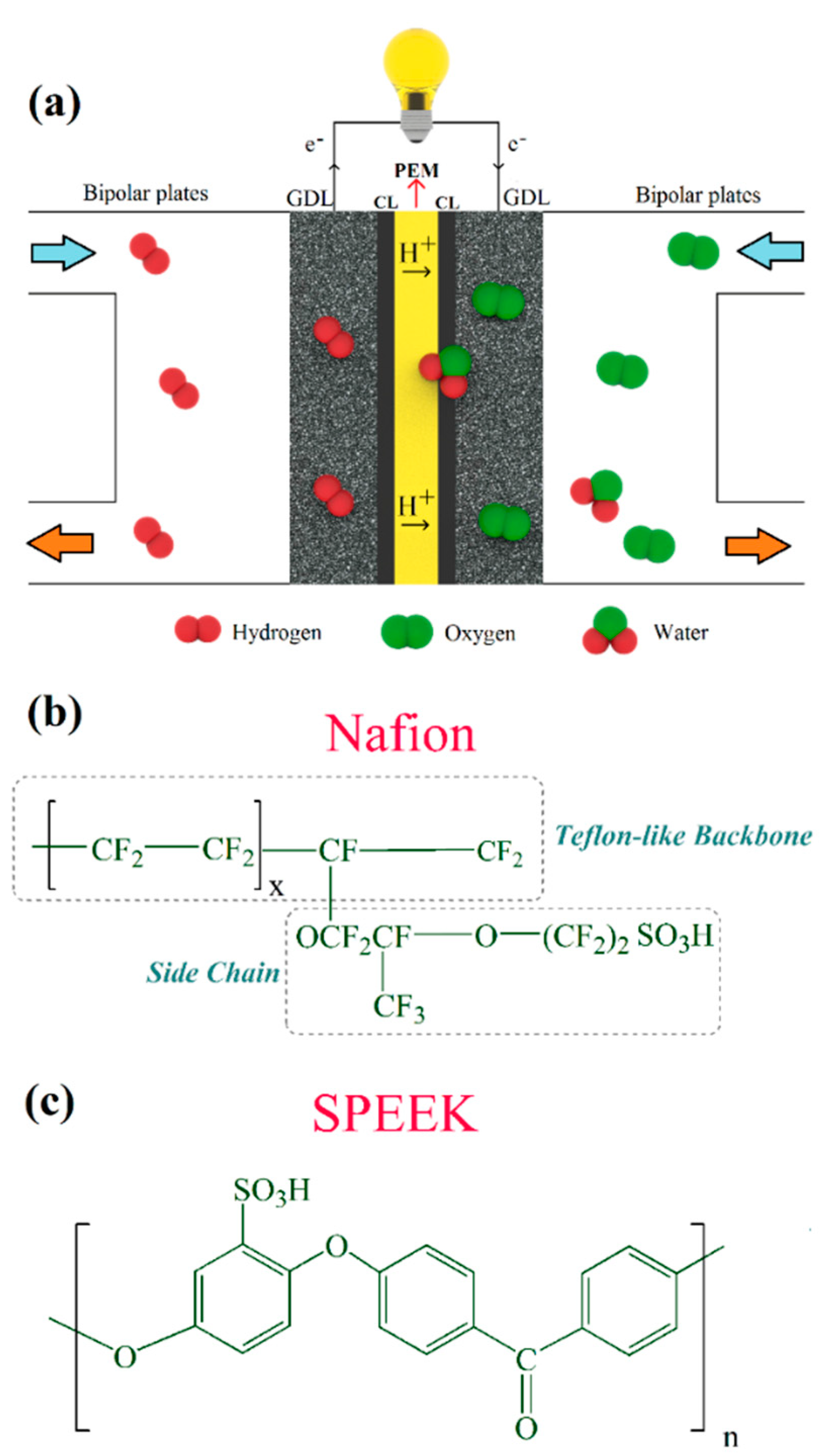
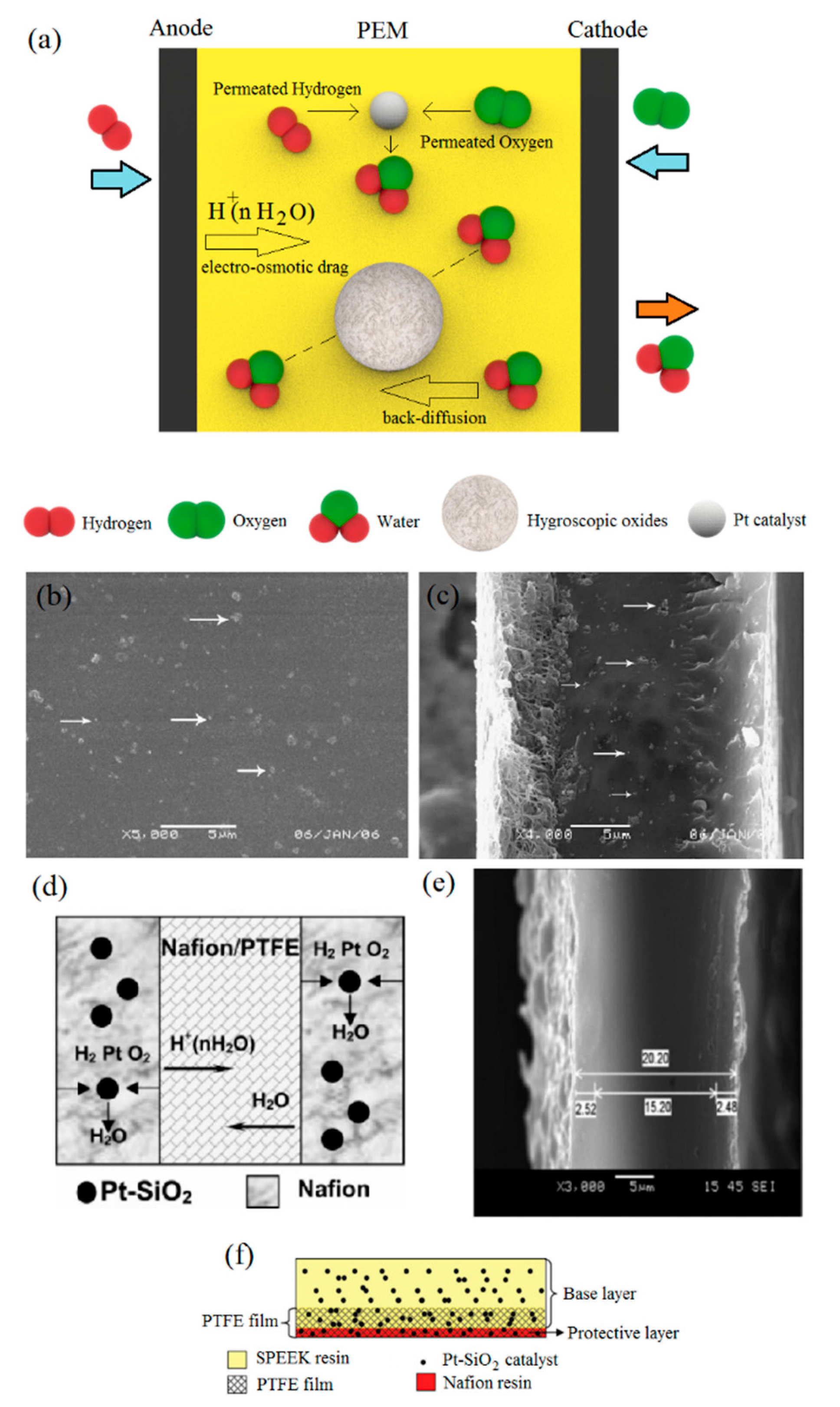
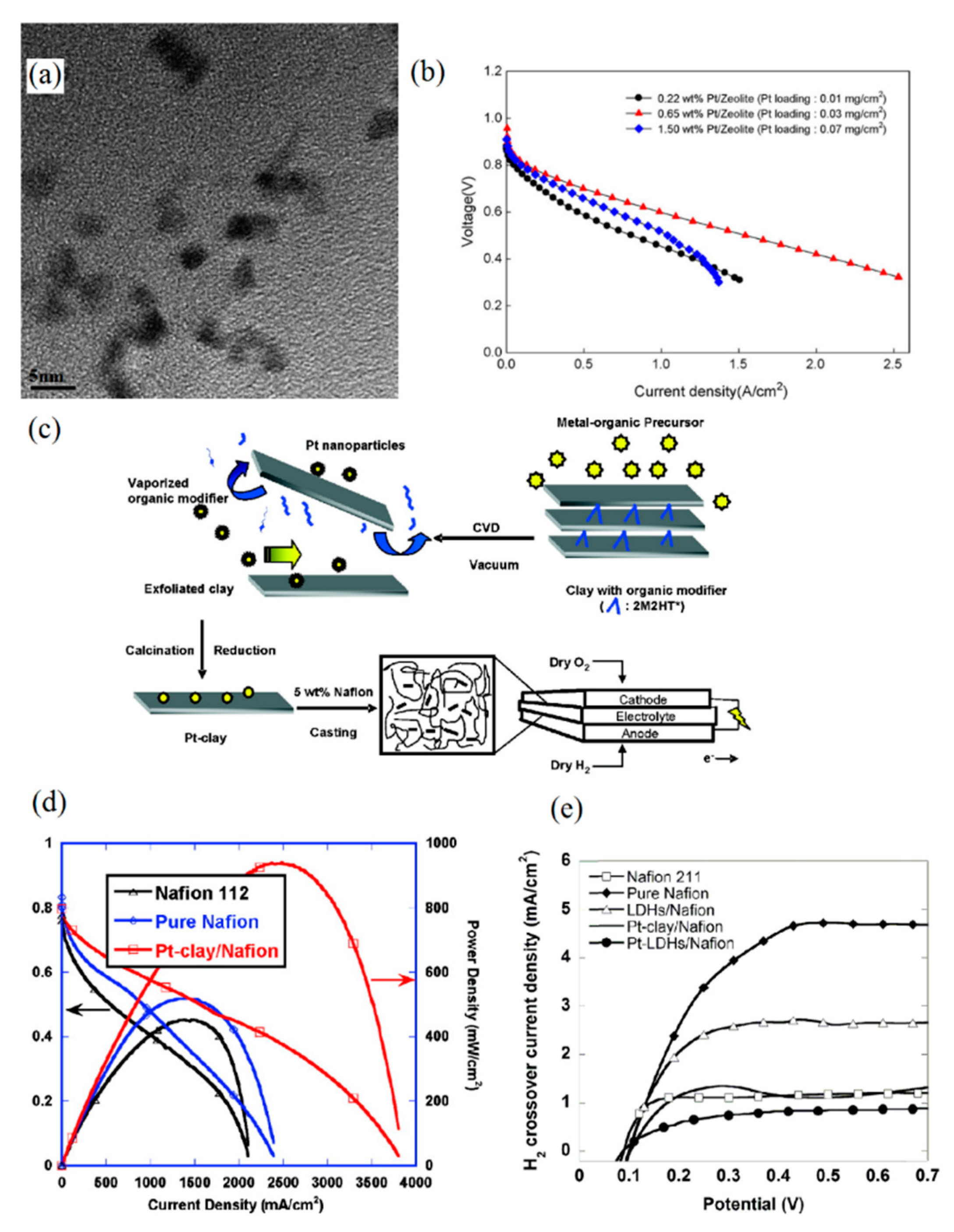

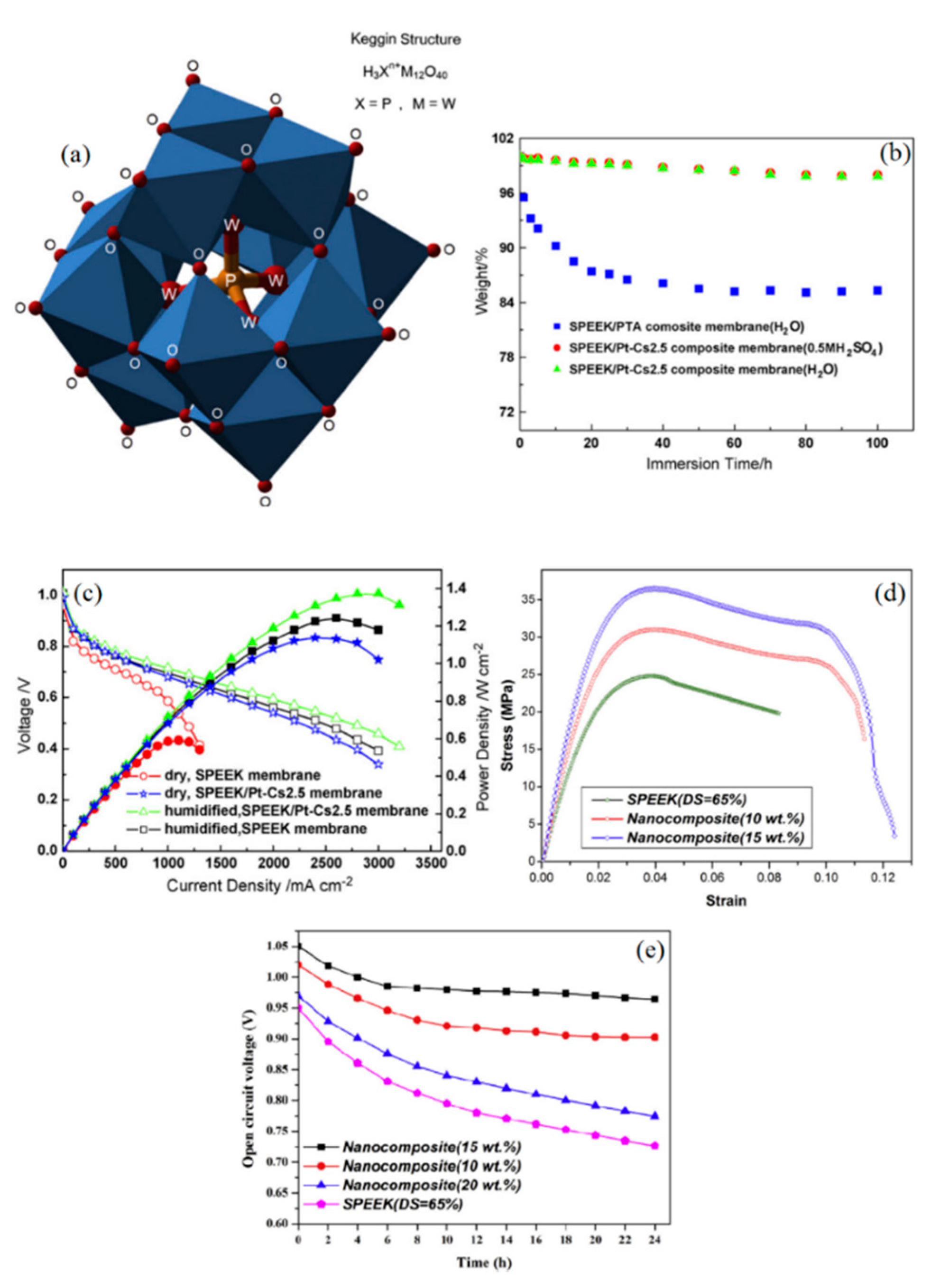


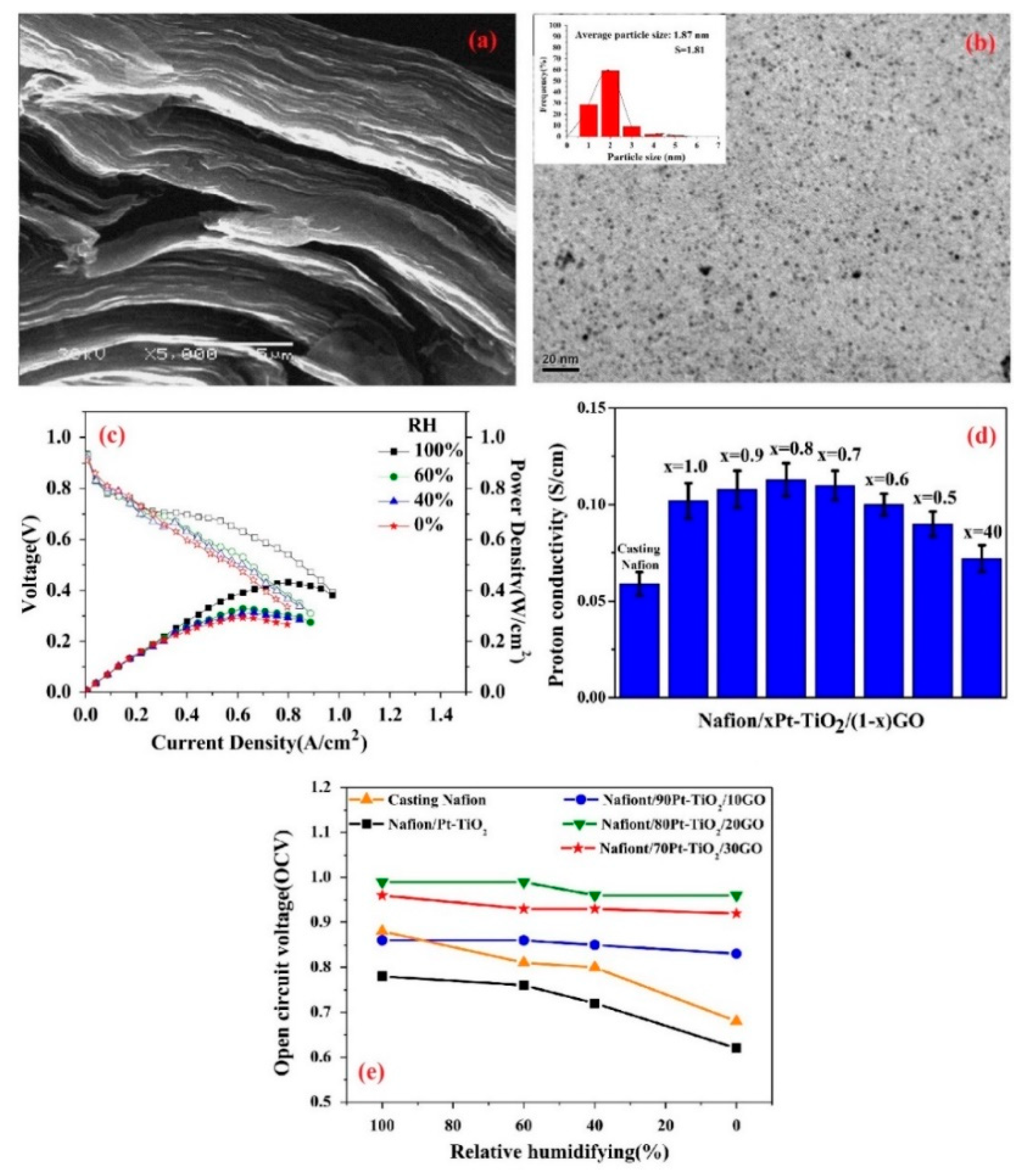
| Samples | Thickness (µm) | Proton Conductivity/IEC | WU (%) | Max. Power Density (W cm−2) | OCV (V) |
|---|---|---|---|---|---|
| Plain Nafion [41] | 50 | - | 16.9 (60 °C) | − | 0.85 (dry) |
| Pt–SiO2/Nafion [41] | 50 | - | 41.2 (60 °C) | − | 0.96 (dry) |
| Nafion 212 [50] | 50 | - | 21.08 (60 °C) | 0.88 (80 °C, dry) | − |
| Pt–SiO2/ Nafion/PTFE [50] | 25 | - | 38.7 (60 °C) | 1.29 (80 °C, dry) | − |
| Nafion/PTFE [51] | 20 | - | 24.5 (≈100 °C) | 0.98 (60 °C, dry) | 0.93 (dry) |
| Pt–SiO2/Nafion/PTFE (Multilayer) [51] | 20 | - | 54.5 (≈100 °C) | 1.4 (60 °C, dry) | 1.032 (dry) |
| SPEEK/PTFE [52] | 24 | 8.5 mS cm−1 (dry) | 24 (60 °C) | 0.33 (60 °C, dry) | 0.94 (dry) |
| Pt–SiO2/SPEEK/PTFE (Multilayer) [52] | 24 | 20 mS cm−1 (dry) | 31 (60 °C) | 0.8 (60 °C, dry) | 0.98 (dry) |
| Pt–TiO2/Nafion [53] | 50 | - | 37.9 (60 °C) | 0.65 (80 °C, dry) | 0.96 (dry) |
| Recast Nafion [54] | 40 | 0.91 meq g−1 | 30.6 (30 °C) | 0.14 (50 °C, dry) | 0.77 (dry) |
| Pt–SA/Nafion [54] | 40 | 0.89 meq g−1 | 42.1 (30 °C) | 0.91 (50 °C, dry) | 0.87 (dry) |
| 0.22 wt % Pt–zeolite HY/Nafion [58] | 50 | - | 10.4 (ambient) | @0.6 V ≈ 0.3 (50 °C, dry) | 0.95 (50 °C, dry) |
| 0.65 wt % Pt–zeolite HY/Nafion [58] | 50 | - | 15.2 (ambient) | @0.6 V ≈ 0.6 (50 °C, dry) | 0.98 (50 °C, dry) |
| 1.5 wt % Pt–zeolite HY/Nafion [58] | 50 | - | 38.6 (ambient) | @0.6 V ≈ 0.45 (50 °C, dry) | 0.96 (50 °C, dry) |
| Pure Nafion [59] | 60 | 13.1 mS cm−1 (25 °C, wet) | 22.5 (25 °C) | ≈0.5 (60 °C, dry) | 0.86 (dry) |
| Pt–clay/Nafion [59] | 60 | 11.1 mS cm−1 (25 °C, wet) | 23 (25 °C) | ≈0.94 (60 °C, dry) | 0.881 (dry) |
| Pure Nafion [61] | 9 | 38 mS cm−1 (60 °C, 70%RH) | - | 0.873 (60 °C, dry) | 0.587 (dry) |
| Pt–LDHs/Nafion [61] | 9 | 39 mS cm−1 (60 °C, 70%RH) | - | 1.174 (60 °C, dry) | 0.705 (dry) |
| Plain SPEEK [68] | 24 | 13 mS cm−1 (40 °C, 100% RH) | 16 (40 °C) | 0.54 (60 °C, dry) | 0.96 (dry) |
| Pt–SZ/SPEEK [68] | 24 | 17 mS cm−1 (40 °C, 100% RH) | 20 (40 °C) | 0.95 (60 °C, dry) | 1.015 (dry) |
| Pt–Cs2.5/SPEEK [77] | 24 | 53 mS cm−1 (60 °C, wet) | 30.6 (60 °C) | 1.14 (60 °C, dry) | 0.99 (dry) |
| Pure SPEEK [80] | 43 | 1.82 meq g−1 | 34.8 (50 °C) | - | 0.831 (dry) |
| Pt–Cs2.5/SPEEK [80] | 45 | 1.96 meq g−1 | 45.9 (50 °C) | - | 1.156 (dry) |
| Pt/Nafion/PTFE [89] | 35 | - | - | - | 0.897 (dry) |
| Pt–C/Nafion/PTFE [89] | 35 | - | - | - | 0.932 (dry) |
| Pt–C/Nafion(Double layer) [90] | 30 | - | - | ≈0.5 (60 °C, dry) | 0.953 (50 °C, wet) |
| Pt–CNT/Nafion (Multilayer) [91] | 25 | - | 22.18 (80 °C) | - | 1.01 (80 °C, dry) |
| Pt–CNF/Nafion [92] | 25 | 0.9 meq g−1 | 25 (80 °C) | 0.688 (50 °C, dry) | ~0.73 (50 °C, dry) |
| Sulfonated Pt–CNF/ Nafion [92] | 25 | 1.12 meq g−1 | 36 (80 °C) | 0.921 (50 °C, dry) | ~0.83 (50 °C, dry) |
| 0.5 wt % Pt–G/Nafion [95] | - | 97 mS cm−1 (ambient, wet) | 31 (ambient) | ≈0.2 (80 °C dry) | 0.77 (80 °C, dry) |
| 3.0 wt % Pt–G/Nafon [95] | - | 100 mS cm−1 (ambient, wet) | 30 (ambient) | ≈0.25 (80 °C, dry) | 0.9 (80 °C, dry) |
| 4.5 wt % Pt–G/Nafion [95] | - | 105 mS cm−1 (ambient, wet) | 29 (ambient) | ≈0.2 (80 °C, dry) | 0.76 (80 °C, dry) |
| 3.0 wt % Pt–G/ 1.5 wt % SiO2/Nafion [96] | - | 91 mS cm−1 (ambient, wet) | 27 (ambient) | ≈0.12 (80 °C, dry) | 0.89 (80 °C, dry) |
| 3.0 wt % Pt–G/ 3.0 wt % SiO2/Nafion [96] | - | 92 mS cm−1 (ambient, wet) | 30 (ambient) | ≈0.13 (80 °C, dry) | 0.96 (80 °C, dry) |
| Casting Nafion [97] | - | 60 mS cm−1 (ambient, wet) | 32.5 (ambient) | ≈0.0 (80 °C, dry) | 0.68 (80 °C, dry) |
| 0.7Pt–TiO2/ 0.3 GO/Nafion [97] | - | 115 mS cm−1 (ambient, wet) | 37.5 (ambient) | ≈0.3 (80 °C, dry) | 0.94 (80 °C, dry) |
| 0.8Pt–TiO2/ 0.2 GO/Nafion [97] | - | 118 mS cm−1 (ambient, wet) | 37 (ambient) | ≈0.5 (80 °C, dry) | 0.97 (80 °C, dry) |
| Recast Nafion [99] | 25 | 122 mS cm−1 (80 °C, wet) | 25.2 (80 °C) | - | ≈0.99 (dry) |
| Pt–PDDA /Nafion/PTFE [99] | 25 | 74 mS cm−1 (80 °C, wet) | 16.3 (80 °C) | - | ≈1.01 (dry) |
| Challenges | Remedies | Ref. |
|---|---|---|
| High ohmic resistance (hygroscopic additives) | Smaller additives with higher surface area can be used. | [41] |
| Hybrid of proton-conductive and hygroscopic materials can be used. | [70] | |
| Functionalization can provide more proton-conductive sites. | [72] | |
| High ohmic resistance (proton conductors) | Either insufficient or excessive amount of additive/catalyst is used. This amount should be optimized. | [80] |
| High ohmic resistance | In any case, thinner membranes can boost proton conductivity. | [61] |
| Mechanical instability of ultra-thin membranes | Can be reinforced with PTFE support. | [50] |
| High gas cross-over rate and low OCV value | Multilayer structures can effectively suppress permeated reactants. | [51] |
| Uniform distribution of catalysts provides abundant recombination active catalytic sites. | [97] | |
| Agglomeration or migration of additives | Surface modification or the functionalization of additives can solve this issue. | [60] |
| Mechanical brittleness | Better dispersion and compatibility with the polymer matrix can improve the mechanical resilience of PEMs. | [81] |
| Electron short circuit | Multilayer approach can eliminate this problem. | [90] |
| Functionalization can solve the electron transfer issue. | [92] | |
| Pt particles can be stabilized by a polymeric matrix with positive charge. | [99] | |
| Free radical-induced chemical degradation in OCV test | Cs2.5H0.5PW12O40 scavenges H2O2 and inhibits free radical formation. | [83] |
| Anode-side dehydration at high current densities | A self-humidifying layer near the anode electrode can prevent dehydration. | [90] |
| Use of thinner membranes can improve water back-diffusion. | [41] |
© 2020 by the authors. Licensee MDPI, Basel, Switzerland. This article is an open access article distributed under the terms and conditions of the Creative Commons Attribution (CC BY) license (http://creativecommons.org/licenses/by/4.0/).
Share and Cite
Mirfarsi, S.H.; Parnian, M.J.; Rowshanzamir, S. Self-Humidifying Proton Exchange Membranes for Fuel Cell Applications: Advances and Challenges. Processes 2020, 8, 1069. https://doi.org/10.3390/pr8091069
Mirfarsi SH, Parnian MJ, Rowshanzamir S. Self-Humidifying Proton Exchange Membranes for Fuel Cell Applications: Advances and Challenges. Processes. 2020; 8(9):1069. https://doi.org/10.3390/pr8091069
Chicago/Turabian StyleMirfarsi, Seyed Hesam, Mohammad Javad Parnian, and Soosan Rowshanzamir. 2020. "Self-Humidifying Proton Exchange Membranes for Fuel Cell Applications: Advances and Challenges" Processes 8, no. 9: 1069. https://doi.org/10.3390/pr8091069







